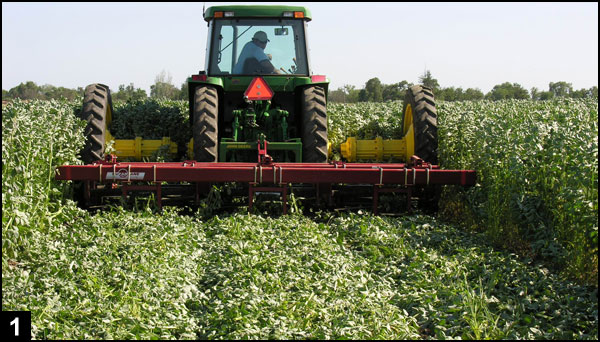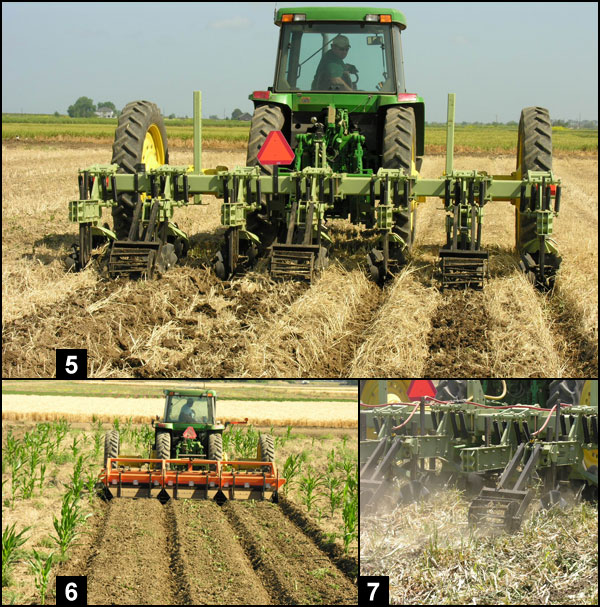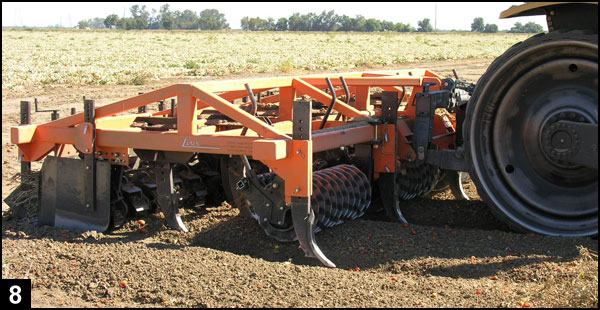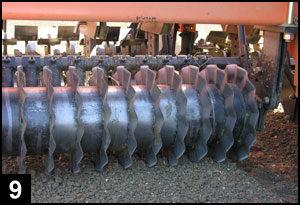| • Table of Contents • |
Winter/Spring 2007 - Vol. 7/No. 2
Equipment options: emphasis on reducing energy consumption
Conventional equipment and tillage operations have long provided growers with proven methods to see their field products through harvest. However, continuously increasing costs associated with skilled labor, fuel and chemical inputs (pesticides, herbicides and fertilizers) have driven the search for additional equipment options. Growers have succeeded in reducing operational costs primarily by 1) accomplishing multiple tasks on each pass through the field, 2) increasing the speed through the field thereby reducing in-field time and 3) reducing overall fuel consumption per pass. Generally, ground-driven and lighter implements require lower operational horsepower and result in a substantial reduction in fuel consumption per acre. The elimination of power take-off-driven implements (PTO) also reduces overall equipment maintenance costs.
Within California and even across individual farms, soil properties and spring moisture conditions can vary greatly. Therefore, attempting to reduce field passes requires that implements be highly adaptable to a wide variety of soils under uncertain weather conditions. Of these, soil moisture in preparation for spring planting can be the most challenging. In wet years with limited existing crop residue, conventional practices often began with a light harrow and furrow-sweeping operation, which effectively dries the soil surface for additional and progressively more substantial tillage operations. An effort to reduce or eliminate these initial field passes has led to an increasing acceptance of strip-tillage and similar methods where only a portion of the soil surface is tilled on each pass. Often spring strip-tillage can be accomplished with lighter tractors when soil conditions may be too wet for heavy tractors and conventional implements. The addition of wheel extensions further serves to distribute equipment weight over greater surface area, potentially reducing furrow disturbance and soil compaction.
 |
 (photos by Dennis Bryant) |
The desired trend to increase the use of winter cover crops in California confronts growers with an additional challenge. What are the most effective tools to manage cover crop residue with the uncertainty of spring weather conditions? In conventional production systems, cover crops can potentially reduce winter runoff and benefit soil properties associated with root mass decomposition. Generally, in these systems the cover crop is “sprayed out” with an herbicide application to reduce pre-plant surface residue to acceptable levels. In contrast, organic producers seek sufficient legume or legume-grass mix cover crop growth to use the residue as a nutrient source for subsequent crops. These systems rely on mowing (Figure 4) or chopping (Figure 1) to initiate “dry down” for incorporation.
In research fields at the UC Davis Center for Integrated Farming Systems (CIFS) site, recent successful cover crop strategies have included legume-grass mixes with an upright growth habit, reducing planting densities and bed-top only plantings. Even so, in years of late spring rains, entry into the field may be delayed, producing greater than optimum biomass. In 2006, a bell bean-wheat cover crop (Figure 2) standing biomass yield was 21.2 tons/acre wet weight (2.5 tons/acre dry weight). This includes approximately 4500 gallons of water per acre as plant moisture, and presents a challenge for conventional flail shredding. Ground-driven reel chopping of this crop (Figure 1) was accomplished at speeds of 6-7 mph, which was greater than four times faster than flailing, and used approximately 50 percent less horsepower. The result is different; material is segmented due to the blade spacing of various types of reel-chop equipment. In comparison, flail mowing (Figure 4) generally produces a slurry, as PTO-driven blades shred the crop biomass.
 |
Subsequently, multiple passes with a bed disc (Figure 3) can achieve full incorporation of cover crop residue, which retains the bed location but thoroughly tills residue and soil. Follow-up equipment is typically needed to create suitable planting conditions.
Alternatively, bed centers can be strip-tilled (Figure 5 and 7) or full-bed ground-driven mulched (Figure 6) in preparation for planting. With either strategy, a ground-driven incorporator can be used post-transplanting (Figure 6). In conventional fields, herbicide application (band or broadcast) and precision fertilizer placement can be completed with either strip-till or ground-driven incorporator techniques.
At the CIFS, a ground-driven bed reformer (Figures 8 and 9) was tested following wheat and processing tomato harvest. Depending upon conditions, the bed reformer is designed to cut residue, bed top and furrow rip, till and reshape the existing beds.
 |
 (photos by Dennis Bryant) |
All equipment options discussed are suitable for buried drip irrigation fields. A wide array of sizes is available to make best use of growers’ existing tractor power options. Various implement width choices make most suitable for use on small fresh-market farms as well as large-scale operations.
The featured implements and tillage options have been tested under field conditions in various crop production systems including winter cover crops, wheat, field corn and processing tomato. Growers should evaluate how this type of equipment fits within the overall management scheme of their particular crop rotations.
Currently, variations of these implements are available from several agricultural equipment manufacturers. Equipment in the photos has been made available by the manufacturers; we would like to thank them for their support of our Agricultural Experiment Station efforts and the agricultural sustainability research programs at the University ofCalifornia, Davis.
We are including these examples of equipment for information to the farm community. When trade names of products have been used, no endorsement of named products by the University of California is intended, nor criticism implied of similar products, which are not mentioned. For more information, contact Dennis Bryant at 530-752-5368, dcbryant@ucdavis.edu.